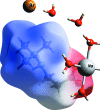Crystal structures of binary compounds of meldonium 3-(1,1,1-tri-methyl-hydrazin-1-ium-2-yl)prop-ano-ate with sodium bromide and sodium iodide
- PMID: 29951240
- PMCID: PMC6002828
- DOI: 10.1107/S2056989018006977
Crystal structures of binary compounds of meldonium 3-(1,1,1-tri-methyl-hydrazin-1-ium-2-yl)prop-ano-ate with sodium bromide and sodium iodide
Abstract
3-(1,1,1-Tri-methyl-hydrazin-1-ium-2-yl)propano-ate (C6H14N2O2, M, more commonly known under its commercial names Meldonium or Mildronate) co-crystalizes with sodium bromide and sodium iodide forming polymeric hydrates poly[[tetra-μ-aqua-di-aqua-bis-[3-(1,1,1-tri-methyl-hydrazin-1-ium-2-yl)propano-ate]disodium] dibromide tetra-hydrate], [Na2(C6H14N2O2)2(H2O)6]Br2·4H2O, and poly[[di-μ-aqua-di-aqua-[μ-3-(1,1,1-tri-methyl-hydrazin-1-ium-2-yl)propano-ate]disodium] diiodide], [Na2(C6H14N2O2)2(H2O)4]I2. The coordination numbers of the sodium ions are 6; the coordination polyhedra can be described as distorted octa-hedra. Metal ions and M zwitterions are assembled into infinite layers via electrostatic inter-actions and hydrogen-bonded networks. These layers are connected via electrostatic attraction between halogenide ions and positive tri-methyl-hydrazinium groups into a three-dimensional structure.
Keywords: 3-(1,1,1-trimethylydrhazin-1-ium-2-yl)propanoate; crystal structure; meldonium; sodium bromide; sodium iodide.
Figures










References
-
- Andrade, L. C. R., Costa, M. M. R., Paixao, J., Agostinho Moreira, J., Almeida, A., Chaves, M. R. & Klopperpieper, A. (1999). Z. Kristallogr. New Cryst. Struct. 214, 83–84.
-
- Andrade, L. C. R., Costa, M. M. R., Pinto, F., Paixao, J. A., Almeida, A., Chaves, M. R. & Klopperpieper, A. (2000). Z. Kristallogr. New Cryst. Struct. 215, 537–538.
-
- Andrade, L. C. R., Costa, M. M. R., Pinto, F., Rodrigues, V. H., Paixao, J. A., Almeida, A., Chaves, M. R. & Klopperpieper, A. (2001). Z. Kristallogr. New Cryst. Struct. 216, 227–228.
-
- Bērziņš, A. & Actiņš, A. (2014). CrystEngComm, 16, 3926–3934.
-
- Bruker (2016). APEX3 and SAINT. Bruker AXS Inc., Madison, Wisconsin, USA.
LinkOut - more resources
Full Text Sources
Other Literature Sources
Molecular Biology Databases
Research Materials
Miscellaneous
